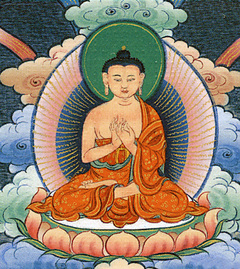First Testament of the Buddha
First Testament of the Buddha
from the Vima Nyingtik
In the language of India: buddha-dhekarayedhu-nāma
In the language of Tibet: sangs rgyas kyi zhal chems dang po zhes bya ba[1]
In the English language: The First Testament of the Buddha
Homage to the great Vajradhara, the sixth completely and perfectly enlightened buddha!
Kyema! Kyema! O children of noble family, consolidate the key points of the whole of Secret Mantra and practise in the following way.
As the preliminaries of body, speech and mind:
Train in impermanence, compassion and bodhicitta.
Since this body was engendered by causal ignorance,
The six classes are present in the seed syllables.
Since rigpa is in actuality the three kāyas,
The three kāyas arise as the three syllables.
Train in the three syllables and make a clear separation (rushen).
Then, to bring about settling in genuine ease,
Revitalize by means of the gazes
Of śrāvakas, bodhisattvas and wrathful deities.
Once you have the confidence of abiding, stability, and freedom,
Relinquish all activity, outward and inward,
And adopt the postures of elephant, lion and sage.
As regards speech, halt the stream of talk.
As for mind, from between the eyebrows focus on space.
By complying with the key points of gates, objects and breath,
Pristine cognition is actualized within the field.
Do not part from the key point of the directly manifest.
With a foundation consisting of threefold motionlessness,
Having obtained the warmth of the four visions,
Take measure of the three forms of settling.
Once you have planted the stake of threefold attainment,
You will never again return to the three realms
But will pass into nirvāṇa—of this there is no doubt.
When the great Vajradhara demonstrated passing into parinirvāṇa in the garden of the physician Jīvaka, in the south of the Heaven of Thirty-Three, Garab Dorje fell to the ground and called out in anguish:
Kyema kyihü! Alas! Alas!
When the lamplight of the teacher has faded,
Who will dispel the darkness of the world?
As he recovered, he saw the Buddha’s right forearm emerge in a mass of light, letting fall a casket of precious crystal, the size of a fingernail, which descended onto the palm of his own right hand. When he opened it and found this instruction written on a precious blue surface in molten lapis lazuli, Garab Dorje gained the confidence of realization.
Samaya.
| Translated by Adam Pearcey with the generous support of the Tsadra Foundation, 2024.
Bibliography
Tibetan Editions
"sangs rgyas kyi 'das rje dang po" In snying thig ya bzhi. 13 vols. Delhi: Sherab Gyaltsen Lama, 1975. Vol. 3: 295–297
"'od gsal rdzogs pa chen po man ngag sde'i gnad kyi bcud phur sangs rgyas kyi 'das rjes gsum" In gdams ngag mdzod. 18 vols. Paro: Lama Ngodrup and Sherab Drimey, 1979–1981 (BDRC W20877). Vol. 2: 2–3
Version: 1.0-20241010
-
This differs slightly in the Khandro Nyingtik version of the text, which adds thams cad (meaning 'all') to make this the testament of all buddhas. ↩
